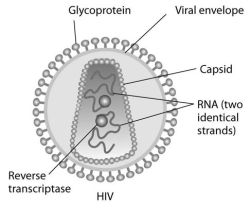Use the following information to answer the questions below.
Human immunodeficiency virus (HIV) infects cells that have both CD4 and CCR5 cell surface molecules. The viral nucleic acid molecules are enclosed in a protein capsid, and the protein capsid is itself contained inside an envelope consisting of a lipid bilayer membrane and viral glycoproteins. One hypothesis for viral entry into cells is that binding of HIV membrane glycoproteins to CD4 and CCR5 initiates fusion of the HIV membrane with the plasma membrane, releasing the viral capsid into the cytoplasm. An alternative hypothesis is that HIV gains entry into the cell via receptor-mediated endocytosis, and membrane fusion occurs in the endocytotic vesicle. To test these alternative hypotheses for HIV entry, researchers labelled the lipids on the HIV membrane with a red fluorescent dye.

-Using live-cell fluorescence microscopy, researchers observed that a red fluorescent spot moved from the plasma membrane into the interior of target cells when red fluorescent dye-labelled HIV was added to the cells. What is the best conclusion from these observations?
Definitions:
Top-Down Processing
A cognitive process that starts with the brain applying what it knows and expects to perceive and interpret new information.
The Fovea
A tiny pit located in the macula of the retina that provides the clearest vision of all; it's responsible for sharp central vision.
The Retina
A layer at the back of the eye that contains cells sensitive to light and triggers nerve impulses that pass via the optic nerve to the brain, where a visual image is formed.
Optic Nerve
The structure at the back of the eye, made up of axons of the ganglion cells, that carries visual information to the brain for further processing.
Q14: When an individual is exercising heavily and
Q19: Which type of organelle or structure is
Q22: Which of the following are nitrogenous bases
Q25: Which of the following is a statement
Q44: Which of the following shows the correct
Q47: The experimental approach taken in current biological
Q48: Which of the following statements correctly describes
Q52: Only once all kinetochores are attached to
Q62: In C. elegans, ced-9 prevents apoptosis in
Q64: The best description of the function of